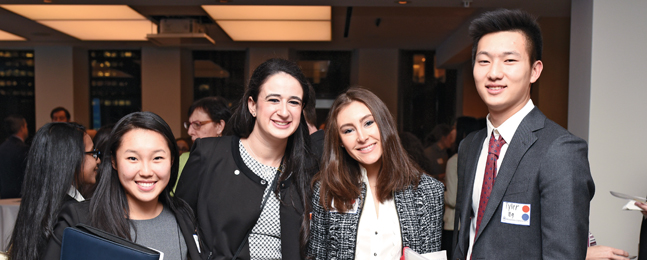Hiatt Survey: Brandeis Grads Reach Their First Career Destination Quickly

SELECTED: Six months after graduation, only 3 percent of Brandeis’ 2017 grads were still looking for a job.
The latest results from the Hiatt Career Center’s annual destination survey are proof positive that Brandeis graduates in all majors don’t waste time as they land a job in their chosen profession or pursue advanced study.
Results from the 2017 survey, published in early February on Hiatt’s Beyond Brandeis website, show that a whopping 97 percent of 2017 Brandeis graduates were either employed, attending graduate school or “meaningfully engaged” in another activity six months after graduation. Only 3 percent were still looking for a job. It’s safe to say that 2018 graduates, entering an even stronger economy in May than their predecessors did, should also fare very well.
This doesn’t mean graduates can relax and wait for the job offers to pour in. “Even in a strong economy, landing a job takes work,” says Andrea Dine, Hiatt’s executive director. “You still need to take all the right steps, starting with walking through our office’s doors.”
Since 2008, Hiatt has surveyed each graduating class about employment status and continuing-education plans. Last year, the response rate hit an all-time high, with more than 80 percent of the senior class completing the survey. Although compiling such data is considered a best practice in higher education, few schools make the data public, Dine says.
The Brandeis results put to rest a common parental question: Will my child be poised for success after graduation? “We’re consistently leading the pack or on par with top-tier institutions,” says Dine. “There’s not much room to grow when you reach a 97 percent success rate.”
According to the survey, 64 percent of 2017 Brandeis graduates joined the workforce; 27 percent enrolled in graduate school; and 6 percent pursued other activities, such as fellowships, volunteer work and travel.
The top sectors for young alumni reflect national trends and correlate with Brandeis’ most popular majors — business, economics, biology, and Health: Science, Society and Policy. Following the trend of previous years, health care was the top industry for 2017 grads (17 percent), followed in equal measure by education and science/research/pharma (both at 13 percent). “Waltham and Boston are part of the booming health-care sector,” says Dine.
Finance and banking drew 10 percent of survey respondents, closely followed by computer science/information technology/ engineering (9 percent). “We had all the top tech companies — Google, Facebook, Amazon Robotics — clamoring to hire our grads,” Dine says.
Relatively few graduates went into performing arts/entertainment (3 percent) or counseling/social services (also 3 percent).
Last year’s graduates are working at organizations that include Walt Disney, Children’s Hospital Boston and Goldman Sachs. They are enrolled at Harvard, Columbia, UCLA and MIT. They live in places as far-flung as Idaho, Colombia and Thailand — more than 20 states and 17 countries in all.
The Hiatt data also correlated each major with a career path. English majors, for example, tended to go into education, advertising, public relations and marketing. Economics majors gravitated toward finance and banking. Anthropology majors often pursued education, health care and community service.
“Our graduates are not only well-positioned to succeed today, but they are also prepared to thrive in a 21st-century economy, no matter what challenges may come,” says Dine.
— Laura Gardner, P’12
